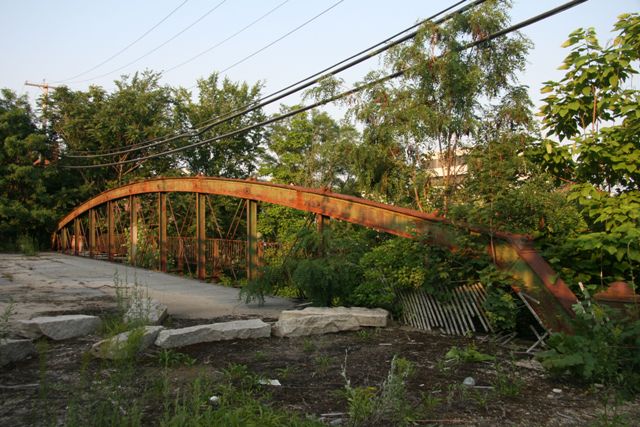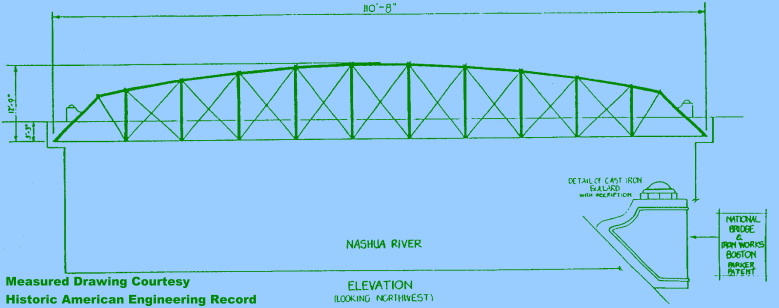We Recommend:
Bach Steel - Experts at historic truss bridge restoration.
BridgeHunter.com Phase 1 is released to the public! - Visit Now
Lower Rollstone Street Bridge

Primary Photographer(s): Nathan Holth and Rick McOmber
Bridge Documented: July 13, 2008
Fitchburg: Worcester County, Massachusetts: United States
1870 By Builder/Contractor: National Bridge and Iron Works of Boston, Massachusetts and Engineer/Design: Charles H. Parker
1980
105.0 Feet (32 Meters)
111.0 Feet (33.8 Meters)
26.6 Feet (8.11 Meters)
1 Main Span(s)
TWN387001100

View Information About HSR Ratings
Bridge Documentation
View Archived National Bridge Inventory Report - Has Additional Details and Evaluation
View Historic American Engineering Record (HAER) Documentation For This Bridge
HAER Data Pages, PDF
View Massachusetts Historical Commission (MHC) Inventory Forms For This Historic Bridge

This bridge is nationally significant as an early example of a truss bridge which used standard interchangeable parts, early enough that the patent that was given to Parker for the design of this bridge and others like it built during the time was done partially for this reason. Unlike bridges before it, the bridge design and proportions could remain constant regardless of the size of the bridge being built. The Charles H. Parker who patented this design is also the same person for whom the Parker truss configuration is named for. It is important to note that the Lower Rollstone Bridge is a bowstring truss following the Parker patent, not a Parker truss itself. However the bridge should be considered further significant as a bridge directly associated with a famous truss bridge engineer.
The bridge is also an early example of a metal bowstring truss bridge, and a noteworthy example of the National Bridge Company's and Parker's take on the bowstring design. Bridge companies had their own very unique bowstring designs during the 1870s as they all experimented with iron to try to find the best way to use the material for the purpose of bridge building. This design of bowstring features a rather massive top chord that includes a corrugation in the interior. The bridge features comparatively lightweight diagonal members. A unique visual detail is the distinctive decorative bollard/post attachments that attach to the actual endpost. Serving as a decorative accent to the bridge, these bollard/posts display the bridge company name.
This nationally significant historic bridge has simply been abandoned and is in an overgrown area where it is difficult to be able to appreciate and enjoy the bridge. A suggested preservation solution for this bridge would be to relocate and restore the structure into a park or non-motorized path. Any restoration project done on this bridge should be of the most meticulous kind, with care being taken to maintain every aspect of the historic integrity of the bridge and its original materials. No parts or materials on this bridge should be replaced with modern substitutes, including rivets. Although the bridge appears to retain good structural integrity, if any parts did need to be replaced, they should be exactly replicated.

![]()
Photo Galleries and Videos: Lower Rollstone Street Bridge
Bridge Photo-Documentation
Original / Full Size PhotosA collection of overview and detail photos. This gallery offers photos in the highest available resolution and file size in a touch-friendly popup viewer.
Alternatively, Browse Without Using Viewer
![]()
Bridge Photo-Documentation
Mobile Optimized PhotosA collection of overview and detail photos. This gallery features data-friendly, fast-loading photos in a touch-friendly popup viewer.
Alternatively, Browse Without Using Viewer
![]()
Maps and Links: Lower Rollstone Street Bridge
Coordinates (Latitude, Longitude):
Search For Additional Bridge Listings:
Bridgehunter.com: View listed bridges within 0.5 miles (0.8 kilometers) of this bridge.
Bridgehunter.com: View listed bridges within 10 miles (16 kilometers) of this bridge.
Additional Maps:
Google Streetview (If Available)
GeoHack (Additional Links and Coordinates)
Apple Maps (Via DuckDuckGo Search)
Apple Maps (Apple devices only)
Android: Open Location In Your Map or GPS App
Flickr Gallery (Find Nearby Photos)
Wikimedia Commons (Find Nearby Photos)
Directions Via Sygic For Android
Directions Via Sygic For iOS and Android Dolphin Browser
USGS National Map (United States Only)
Historical USGS Topo Maps (United States Only)
Historic Aerials (United States Only)
CalTopo Maps (United States Only)

